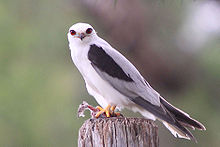Elanus
Elanus
Genus of birds-of-prey
Elanus is a genus of bird of prey in the elanine kite subfamily. It was introduced by the French zoologist Jules-César Savigny in 1809 with the black-winged kite (Elanus caeruleus) as the type species.[2][3] The name is from the Ancient Greek elanos for a "kite".[4]
These are white and grey raptors of open country, with black wing markings and a short square tail. They hunt by slowly quartering over mainly savanna habitat for rodents and other small mammals, birds and insects, sometimes hovering like a kestrel. The primaries and secondaries have soft barbules from the upper surface that help in owl-like silent flight. The genus Elanus is distinctive in having very small scales covering the foot and on the underside, scutellate scales are found only under the terminal phalanges. The claw lacks a groove on the underside. They also have eyesight suited for crepuscular rodent hunting.[5][6] The genus contains four species, all of which hunt small mammals, especially rodents, by hovering in the air while looking for them in over open savanna habitats.[7] For some time, these species were all included as subspecies of Elanus caeruleus, which has been known as the black-shouldered kite.[8][9][10]
The letter-winged kite breeds colonially and is nocturnal. The other species are both diurnal and crepuscular.[6][11]








